Guest Blog by John McLean
Hardly a day goes by without a new claim about a human influence on climate. In the last 18 months we’ve been told, not once but three times, that the air circulation across the tropical Pacific is slowing down and it’s all our fault.
The problem is that the scientific papers making those claims have somehow managed to completely ignore the Great Pacific Climate Shift of 1976 despite this being well-known to climatologists. The changes caused by that climate shift can account for the altered circulation pattern. Despite what the three papers say we don’t need to include any human influence.
Was the omission of the Climate Shift deliberate or accidental through ignorance? Neither is particularly palatable in such a controversial field where we expect, but don’t always get, impartial and accurate science.
Of course such an omission in peer-reviewed papers doesn’t reflect well on the reviewers and journals in question, but many of us are used to that bias by now.
See the full analysis here.

In full support of John’s thesis is the above plot of Mantua’s PDO since 1950 with a predominance of the cold phase (La Nina (blue spikes)) until 1976 and then the warm phase (El Nino (red spikes)) after
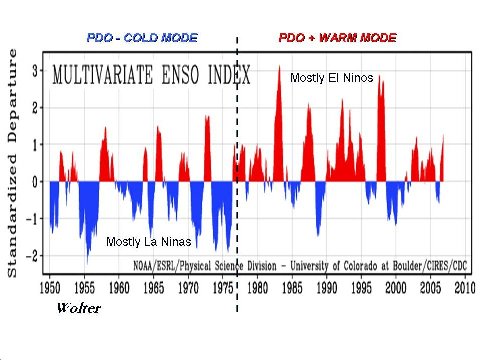
By Lubos Motl, The Reference Frame
The members of the global warming movement have offered us another piece of evidence that their thinking and behavior is not too different from the Nazis and communists. The State Climatologist of Virginia and one of the most esteemed U.S. climate scientists, Prof Patrick Michaels, was effectively stripped of his title.
Environmentalist activists complained that Michaels’ opinions could be interpreted as the official climatological opinions of the state of Virginia. Well, it was my understanding that this was exactly the very purpose of the chair of the state climatologist. Who else should determine the key answers about the climate in that state?
But the green scum simply didn’t like Michaels’ conclusions. So they just fired him through a disgraceful governor, Mr Tim Kaine, and replaced him with a Philip “Jerry” Stenger. Let’s now look what scientific credentials were sacrificed in the name of an ideology. Google’s Scholar finds 411 articles with Michael’s name and those that he co-authored have hundreds of citations. Among 9 papers with the name of Stenger, only a few were co-authored by Stenger and all of those have Michaels on the author list, too. Nevertheless, the total citation count of Stenger seems to be 1 citation.
For purely ideological reasons, the quality of the office of the State Climatologist of Virginia was reduced by nearly three orders of magnitude. As a reader says, sharp scientists are being replaced by party officials. Much like the activists in Germany of the 1930s, these people are plain mad. They never realize that a possible decision could simply be over the edge. They are ready to do absolutely anything and everything for their silly unscientific ideology.
Read more of Lubos’s blog here.
By Steve McIntyre, Climate Audit Blog
As noted before, climateaudit readers have helped UCAR find the lost civilization of Chile and today, we are happy to report that we have helped NASA find the lost city of Wellington NZ. NASA’s records for Wellington NZ were mysteriously interrupted in 1988 - an interruption so severe that we assumed that Wellington NZ must have been destroyed by Scythians. We are happy to report that Wellington NZ is still in existence.
This is not the only good news. We are also happy to announce that there is still a functioning meteorological service. Not only that, but can announce contact with the indigenous representatives. Although NASA (and NOAA) appear to have lost contact, an indigenous NZ climate scientist familiar with the lost records has contacted climateaudit. I have passed this exciting news on to NASA and urged them to restore contact with their lost cousins in NZ. Previously, we had shown the following graphic showing the termination of NASA records in 1988 and the adding of a substantial trend to the Wellington NZ record in the Hansen adjustment.
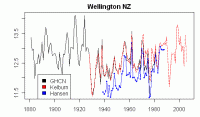
If one is allowing for urbanization in Wellington for the period since 1928 (presuming a non-homogeneity at 1928) to the present, then there is no physical theory under which the adjustment should reduce earlier measurements as Hansen has done. Exactly how Hansen’s algorithm effected this reduction still remains somewhat of a mystery (which we are working on). Whether this particular Hansen error, whatever it is, creates an overall bias also remains to be determined. But the adjustment makes no sense in this particular instance, so there is obviously something wrong somewhere. See the blog here.
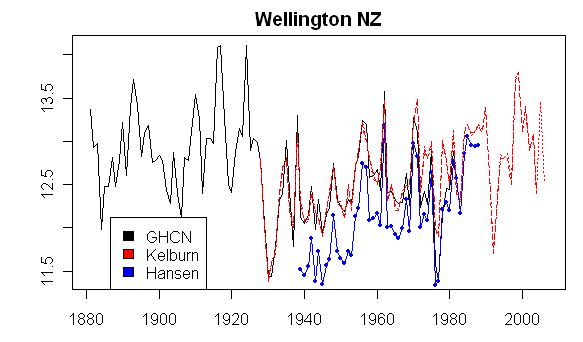
By World Climate Report
In 2006, an article appeared in Science magazine reconstructing the temperature of the Northern Hemisphere back to 800 AD based on 14 smoothed and normalized temperature proxies (e.g., tree ring records). Osborn and Briffa proclaimed at the time that “the 20th century is the most anomalous interval in the entire analysis period, with highly significant occurrences of positive anomalies and positive extremes in the proxy records.” Obviously, concluding that the Northern Hemisphere has entered a period of unprecedented warmth is sure to make the news, and indeed, Osborn and Briffa’s work was carried in papers throughout the world and was loudly trumpeted by the American Association for the Advancement of Science (AAAS) that publishes the journal Science.
A recent issue of Science contains an article not likely to receive any press coverage at all. Gerd Bürger of Berlin’s Institut für Meteorologie decided to revisit the work of Osborn and Briffa, and his results raise serious questions about the claim that the 20th century has been unusually warm. Bürger argues that Osborn and Briffa did not apply the appropriate statistical tests that link the proxy records to observational data, and as such, Osborn and Briffa did not properly quantify the statistical uncertainties in their analyses. Bürger repeated all analyses with the appropriate adjustments and concluded “As a result, the ‘highly significant’ occurrences of positive anomalies during the 20th century disappear.” Further, he reports that “The 95th percentile is exceeded mostly in the early 20th century, but also about the year 1000.” Needless to say, Gerd Bürger is not going to win any awards from the champions of global warming – nothing is more sacred than 20th century warming! Read more here.
By Mark Gongloff, WSJ Energy Roundup Blog
Maybe there haven’t been enough Live Earth concerts. Maybe a weakening economy and turbulent markets have people pinching pennies. Maybe there have been too many Live Earth concerts. Whatever the reason, consumers may be souring on the idea of “going green,” if a new survey is any indication. Just 69% of the 504 consumers polled in August by Shelton Group, a Knoxville, Tenn., marketing firm, would favor one house over another based on energy efficiency, down from 86% a year ago.
“Even with all the talk today about consumers seeking to save energy costs and help the environment, the shaky housing market and other recent economic uncertainties prove that wallets are still driving many Americans’ green purchase decisions,” Shelton Group CEO Suzanne Shelton said in a press release. “As it stands, ‘energy-efficient’ is consistently equated to ‘more expensive’ in the minds of consumers for products across the board,” Shelton said.
The full survey results are due for release on Oct. 8. Without offering any details, the Shelton Group warned that companies engaging in “greenwashing” — making themselves look environmentally friendly without doing much to actually help the environment — should beware. “[C]ompanies jumping on the green-friendly bandwagon but failing to make the grade as environmentally responsible in all aspects of their products and operations face both a skeptical public and potential credibility problems,” the group said in its press release. Read more here.
Separating Climate Fact from FictionBy Timothy Ball and Tom Harris, NSRP, in the Washington Times
This week is especially challenging for citizens trying to separate fact from fantasy in the climate debate. From the excited rhetoric of United Nations Secretary-General Ban Ki-moon’s high-level event in New York, the pontifications of Ted Turner at the Clinton Global Initiative or politicians pandering for the green vote at President Bush’s leaders summit, the public is in dire need of self-defense strategies.
The most reliable tool is simple skepticism. “I don’t believe you; prove it” is an appropriate response to Al Gore and his climate campaigners. But such a charge is politically incorrect when applied to climate change so most people need something more passive, a climate change propaganda detector. See the story for the list of things that should cause alarm bells to ring on a properly tuned detector.
Climate alarmism may defeat itself by simply overplaying its hand. This week’s conferences could speed that process, helping end what is becoming the most expensive science swindle in history. Let’s hope so.
By Joe D’Aleo, ICECAP
There have been and will continue to be stories on the new record minimum of arctic ice and how this is further proof of anthropogenic global warming. As we have blogged, the authors of the papers and media reporting on them have no sense of history and of the real factors involved in the global cycles of temperatures and arctic ice.
In the attached UPATED pdf we will use the excellent discussions of the NSIDC updated weekly on the sea ice extent and some of our own analyses previously blogged to show you much of this is cyclical and driven by the multidecadal cycles in the oceans, and influenced this summer by an unusual summer weather pattern.
This excellent animation by NSIDC from 1981 to 2007also shows how arctic ice has varied and moved in recent decades on an annual basis due to the global pattern changes.

By Craig James, Wood TV Blog
The headline in this press release from the European Space Agency reads “Satellites witness lowest Arctic ice coverage in history”. In history! That sounds like a long time. However, when you read the article you find “history” only goes back to 28 years, to 1979. That is when satellites began monitoring Arctic Sea ice. The article also says “the Northwest Passage – a long-sought short cut between Europe and Asia that has been historically impassable.” I guess these people flunked history class. It has been open several times in history, without ice breakers. The first known successful navigation by ship was in 1905.
This is all very similar to the story on the NBC Nightly News Friday, 14 Sep 07 where the story on water levels in Lake Superior never mentioned that the lowest recorded water level on the lake occurred in March and April 1926, when the lake was about 5 inches lower than it is now. Instead, NBC interviewed several people who could never remember seeing it this low and blamed most of the problem on global warming. Never mind that the area has seen below normal precipitation for several years and for most of this year has been classified as being in an extreme to exceptional drought.
A spokesman for the Army Corps of Engineers has said ” Global warming could be an underlying cause, but the scientists said it’s too soon to know. We need to do more tracking,” also, “The last time Lake Superior was so low was November and December 1925 and January through September 1926, during a long drought that preceded the great dust bowl.”
Brian Williams actually led into the story by saying that much of the Great Lakes area has been wet. But why let facts get in the way of a good global warming story? And they wonder why not as many people watch television news anymore.
Read Craig’s blog here.
By World Climate Report
We have heard a million times that if we don’t stop emitting greenhouse gases, our inexcusable actions will result in a warmer earth, and the warming of the planet will cause icecaps and mountain glaciers to melt and sea level to rise. Island nations will be drowned, coastlines around the world will go underwater, Florida will cease to exist, and the World Trade Center Memorial could someday be a sight seen only by scuba enthusiasts.
We have covered this sea-level rise issue many times in the past at World Climate Report and we fully agree that sea level is rising – sea level has been somewhat steadily rising for the past 10,000 years. During the last glacial advance, a large amount of fresh water was tied up in ice, and as the glaciation ended, that water returned to the oceans. Furthermore, as the earth warmed up following the last glacial advance, thermal expansion of the ocean water occurred, and sea level rose even more. There is little doubt that the sea-level rise will continue into the future, but the rate of rise is the focus of an interesting paper published recently in Global and Planetary Change by a team of scientists from France and Spain.
When the authors (Wöppelmann et al.) factored their measurements of land motion into the estimate of sea-level rise, they determined a global value of 1.31 ±0.30 mm per year compared to the 1.8±0.5 mm per year value given by the IPCC for the recent half century. We understand that the IPCC acknowledges a low-end value of 1.3 mm per year in their estimate, but another way to look at this article is that Wöppelmann et al. just reduced observed sea-level rise by 27%! Perhaps the IPCC should reconsider whether they still have high confidence that the rate of sea level rise has in fact increased from the 19th to the 20th century.Of course, these results gained absolutely no press coverage whatsoever – imagine the coverage they would have received had their results increased sea-level rise by 27% and suggested that sea level rise was occurring faster then previous research indicated! See full report here.
By Anthony Watts, Watts Up with That?”
Anthony’s slideshow on the station siting issues can be found here.
With 33% of the USHCN weather station network now surveyed, the site quality rating is now applied. The rating system for site quality was borrowed verbatim from the new Climate Reference Network being put into operation by NCDC and NOAA to ensure quality data. Their siting criteria can be found here.
I welcome input on this work in progress. The site rating will now be a running total in the spreadsheet and always available online as new stations are added to the survey. What is important to note is that the majority of stations that have a rating of 4 are MMTS/Nimbus equipped stations, which according to NCDC’s MMS equipment lists, make up 71% of the USHCN network. It appears that cable issues with the electronic sensors have forced them closer to buildings, roads, etc because NOAA COOP managers don’t often have the budget, time, or tools to trench under roads, sidewalks etc to reach the site where Stevenson Screens once stood. While this isn’t always the case, a pattern is emerging.
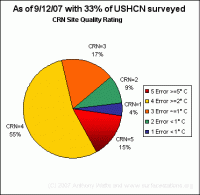
See larger image here. See Watt’s full blog and site here.
Steve Mcintyre has done a plot of the best versus the worst sited temperatures here.
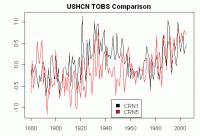
See larger image here.
Fire (Relationship to Global Warming)—SummaryBy CO2 Science
In the Gospel According to Gore, i.e., his book An Inconvenient Truth, Al Gore writes that “wildfires are becoming much more common as hotter temperatures dry out the soil and the leaves,” and to support this claim he presents a bar graph which, as he describes it, “shows the steady increase in major wildfires in North and South America over the last five decades,” noting that “the same pattern is found on every other continent as well.”
How correct are these claims?
As shown in this summary, although one can readily identify specific parts of the planet that have experienced both significant increases and decreases in land area burned over the last two to three decades of the 20th century, as we have done in the materials reviewed above, for the globe as a whole there was absolutely no relationship between global warming and total area burned over this latter period, when climate alarmists claim the world warmed at a rate and to a degree that were both unprecedented over the past several millennia. As a result, it should be abundantly clear there is simply no truth to the contention of Al Gore that the pattern of increasing wildfires over the last three decades of the 20th century, which he plots for North and South America, “is found on every other continent as well.” To reprise a portion of a favorite quote of his (An Inconvenient Truth, p. 20-21), it just ain’t so.
While the news focus has been on the lowest ice extent since satellite monitoring began in 1979 for the Arctic, the Southern Hemisphere (Antarctica) has quietly set a new record for most ice extent since 1979.
This can be seen on this graphic from this University of Illinois site The Cryosphere Today, which updated snow and ice extent for both hemispheres daily. The Southern Hemispheric areal coverage is the highest in the satellite record, just beating out 1995, 2001, 2005 and 2006. Since 1979, the trend has been up for the total Antarctic ice extent.
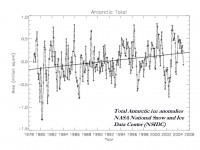
While the Antarctic Peninsula area has warmed in recent years and ice near it diminished during the Southern Hemisphere summer, the interior of Antarctica has been colder and ice elsewhere has been more extensive and longer lasting, which explains the increase in total extent. This dichotomy was shown in this World Climate Report blog posted recently with a similar tale told in this paper by Ohio State Researcher David Bromwich, who agreed “It’s hard to see a global warming signal from the mainland of Antarctica right now”.
Indeed, according the NASA GISS data, the South Pole winter (June/July/August) has cooled about 1 degree F since 1957 and the coldest year was 2004.
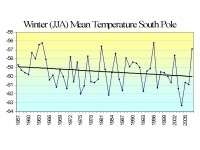
This winter has been an especially harsh one in the Southern Hemisphere with cold and snow records set in Australia, South America and Africa. We will have recap on this hard winter shortly. See full story here.
By Joe D’Aleo, ICECAP
A series of reports by the USGS were released Friday predicting tough sledding ahead for the world’s polar bear populations. More than two-thirds of the world’s polar bears will be killed off by 2050 — including the entire population in Alaska — because of thinning sea ice from global warming in the Arctic, government scientists forecast Friday. See in this blog why the evidence does not suggest that rising temperature endangers them or will cause their extinction but don’t let the facts get in the way of a good cause.

Jeff Masters in his Wunderground blog yesterday projected the decrease in arctic ice the last few decades will continue, eventually leaving the arctic ice free by 2030. He gets there by comparing the ice in 1979 to the ice cover in 2007 and noting it was disappearing faster than the climate models showed it would. He notes that although this will have little effect on sea level it will mean we have to reevaluate the melting of the Greenland icecap and revise its demise sharply upwards. This he notes would have a much greater effect on sea level. Again Jeff and the researchers he quotes have little regard or understanding of the history nor understanding of the true factors at play in the cyclical changes in the arctic and Greenland (and the globe for that matter). See more here.
By World Climate Report
The ice caps are melting – right? If you visit thousands of websites on climate change, watch Gore’s film or many similar documentaries, you would be left with no doubt that the icecaps are warming and melting at an unprecedented rate. However, with respect to Antarctica, you might be surprised when you examine what the United Nations Intergovernmental Panel on Climate Change says in their 2007 Summary for Policymakers. Believe it or not, IPCC reports “Antarctic sea ice extent continues to show inter-annual variability and localized changes but no statistically significant average trends, consistent with the lack of warming reflected in atmospheric temperatures averaged across the region.” Furthermore, they note “Current global model studies project that the Antarctic ice sheet will remain too cold for widespread surface melting and is expected to gain in mass due to increased snowfall.”
A major article on this subject appears in a recent issue of the Journal of Climate by William Chapman and John Walsh of the University of Illinois. The two scientists extensively review the literature on temperature trends in Antarctica and conclude “These studies are essentially unanimous in their finding that the Antarctic Peninsula has warmed since the 1950s, when many of the surface stations were established.” They note “Recent summaries of station data show that, aside from the Antarctic Peninsula and the McMurdo area, one is hard-pressed to argue that warming has occurred, even at the Antarctic coastal stations away from the peninsula and McMurdo.” Furthermore, they write “Recent attempts to broaden the spatial coverage of temperature estimates have shown a similar lack of evidence of spatially widespread warming.” Like it or not, over the past four decades, and during the time of the greatest build-up of greenhouse gases, Antarctica has been cooling!
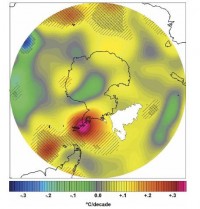
Linear trends of annual mean surface air temperature (°C/decade) for the period 1958–2002 from Chapman and Walsh, 2007
Read full report and analysis of this paper here.
The Inconvenient Truth about the Ice Core Carbon Dioxide Temperature CorrelationsBy Nir Shaviv, Science Bits
One of the “scientific” highlights in Al Gore’s movie is the discussion about the clear correlation between CO2 and temperature, as is obtained in ice cores. To quote, he says the following when discussing the ice-core data (about 40 mins after the beginning for the film): “The relationship is actually very complicated but there is one relationship that is far more powerful than all the others and it is this. When there is more carbon dioxide, the temperature gets warmer, because it traps more heat from the sun inside.”
Any laymen will understand from this statement that the ice-cores demonstrate a causal link, that higher amounts of CO2 give rise to higher temperatures. Of course, this could indeed be the case, and to some extent, it necessarily is. However, can this conclusion really be drawn from this graph? Can one actually say anything at all about how much CO2 affects the global temperature?
To the dismay of Al Gore, the answer is that this graph doesn’t prove at all that CO2 has any effect on the global temperature. The main evidence proving that CO2 does not control the climate, but at most can play a second fiddle by just amplifying the variations already present, is that of lags. In all cases where there is a good enough resolution, one finds that the CO2 lags behind the temperature by typically several hundred to a thousand years.
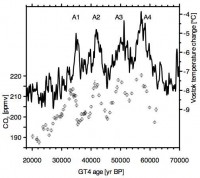
Analysis of ice core data from Antarctica by Indermühle et al. (GRL, vol. 27, p. 735, 2000), who find that CO2 lags behind the temperature by 1200±700 years.
See more in this excellent blog here.




